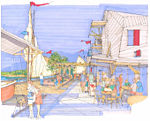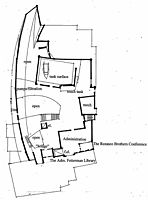Difference between revisions of "Fetterman Maritime Museum"
m (→Renderings) |
m (Admiral John H. Fetterman State of Florida Maritime Museum and Research Center moved to Fetterman Maritime Museum: title was too long) |
||
| (One intermediate revision by the same user not shown) | |||
| Line 13: | Line 13: | ||
*$100,000 donated by [[Robert C. Rosasco]] to create a conference room in honor of timber magnates [[Albert T. Rosasco|Albert T.]] and [[William T. Rosasco]]. | *$100,000 donated by [[Robert C. Rosasco]] to create a conference room in honor of timber magnates [[Albert T. Rosasco|Albert T.]] and [[William T. Rosasco]]. | ||
*Navy memorabilia salvaged from [[Trader Jon's]], to be displayed in the museum's first floor restaurant, donated by law firm of [[Aylstock Witkin & Sasser]] and valued at over $2 million. | *Navy memorabilia salvaged from [[Trader Jon's]], to be displayed in the museum's first floor restaurant, donated by law firm of [[Aylstock Witkin & Sasser]] and valued at over $2 million. | ||
| + | *$20,000 donated by [[Anna Whibbs]] and the [[Whibbs family]] in honor of the late [[Vince Whibbs]]. | ||
==Renderings== | ==Renderings== | ||
Latest revision as of 13:39, 12 February 2008
The Admiral John H. Fetterman State of Florida Maritime Museum and Research Center is a 50,000 square foot museum planned to be part of the Vince Whibbs Sr. Community Maritime Park. It is named for Vice Admiral Jack Fetterman, who conceived the idea and championed its creation until his death.
The museum, which will also serve as headquarters for the Florida Public Archaeology Network, will contain educational displays about Pensacola's maritime history, from early European explorers, to the shipping boom brought by the lumber and railroad industries, to the more recent naval presence. Artifacts from some of the hundreds of ships sunk in Pensacola Bay will be on display, and visitors will be able to observe and participate in University of West Florida research projects in the fields of public history, underwater archaeology, marine biology and environmental science. The museum will also house an aquarium.
Funding[edit]
The cost of the museum is estimated to be $18 million. Thanks to the State of Florida’s Alec P. Courtelis Matching Gift Program, only $9 million in private donations will be required. The honorary chairs of the fundraising committee are U.S. Senators Bill Nelson and John McCain, former "Good Morning America" host David Hartman, New Orleans Saints owner Tom Benson, and Nancy Fetterman, UWF Trustee and Admiral Fetterman's widow.
In the first half of 2007, the Pensacola News Journal co-sponsored a "Do It!" fundraising campaign for the museum, in which members of the community were invited to make personal donations that were matched by the "Do It!" corporate partners, which included the News Journal, the Gulf Power Foundation, McGuire's Irish Pub, the Nature Trail subdivision and Whitney Bank. Those monies were then doubled again by the Alec P. Courtelis Matching Gift Program, so the campaign's goal of $250,000 actually yielded $1 million for the museum.
Other donations that have already been made to the museum (and that will be doubled by the matching program) include:
- $500,000 donated by Ted Brown and Kathy Horton-Brown to honor Brown's father, Captain S. J. Brown, founder of Brown Marine Service.
- $100,000 donated by Robert C. Rosasco to create a conference room in honor of timber magnates Albert T. and William T. Rosasco.
- Navy memorabilia salvaged from Trader Jon's, to be displayed in the museum's first floor restaurant, donated by law firm of Aylstock Witkin & Sasser and valued at over $2 million.
- $20,000 donated by Anna Whibbs and the Whibbs family in honor of the late Vince Whibbs.
Renderings[edit]
On May 24, 2007, a detailed conceptual design by Doug Mund was unveiled. Renderings and floor plans of the three-story museum show a curved exterior wall (evoking a seafaring vessel) with a restaurant on the first floor, an interactive theater on the second floor, a "touch tank" on the third floor, and a 125,000 gallon ocean tank that spans all three levels. CMPA board chairman Lacey Collier praised the concept, saying, "I always evaluate places myself when you walk in if it makes you say, 'Wow!' I think we have a double wow here."[1]







